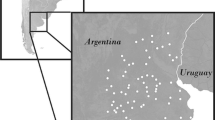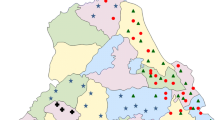Abstract
In many tropical soils, excessive weathering of primary minerals confounded by intense agricultural production has resulted in the depletion of organic matter and plant available forms of phosphorus (P). Long-term growth of cover crops in tropical agroforestry systems have been shown to influence nutrient cycling, and soil organic matter pools. The objective of this experiment was to assess the affect of 2 years of cover-crop cultivation on organic matter accumulation and P bioavailability using Mehlich I and sequential fractionation methods. The experiment included six treatments in the understory of a cacao-plantain agroforestry system adjacent to lower montane tropical forests of the San Martin district of Eastern Peru. Cacao and plantain formed the primary canopy on otherwise abandoned agricultural land. The treatments consisted of four perennial leguminous cover crops (Arachis pintoi, Calopogonium mucunoides, Canavalia ensiformis, and Centrosema macrocarpum), a non-legume cover crop (Callisia repens), and a control treatment (no cover crop). After only 2 years of cultivation, results suggest that all cover crop species accessed residual P pools in 0–5 cm soil depths as indicated by a decrease in the 0.5 M HCl extractable P pools when compared to control. Additional use of residual P pools by A. pintoi and C. macrocarpum were indicated by significant reduction in the 6.0 M HCl extractable P pool. Relative to control, there was no treatment effect on soil organic matter content; however significant differences occurred between treatments. The C. ensiformis, C. mucunoides and C. repens treatments in 5–15 cm soil depths contained significantly more organic matter than the A. pintoi treatment. In 15–30 cm soil depths the C. ensiformis treatment contains significantly more organic matter than the A. pintoi treatment. Continued research should focus on monitoring the long-term effects of cover crop cultivation on the bioavailability of soil P pools in surface soil horizons, development of organic matter pools and the productivity of the agroforestry species.

Similar content being viewed by others
References
Appiah MR, Sackey ST, Ofori-Frimpong K, Afrifa AA (1997) The consequences of cacao production on soil fertility in Ghana: a review. Ghana Journal of Agricultural Science 30:183–190
Baligar VC, Fageria NK (2007) Agronomy and physiology of tropical cover crops. Journal of Plant Nutrition 30:1287–1339. doi:10.1080/01904160701554997
Barber SA (1995) Nutrient absorption by plant roots. In: Barber SA (ed) Soil nutrient bioavailability: a mechanistic approach. Wiley, New York, pp 49–84
Barroso CB, Nahas E (2005) The status of soil phosphate fractions and the ability of fungi to dissolve hardly soluble phosphates. Appl Soil Ecol 46. doi:10.1016/j.apsoil.2004.09.005
Basamba TA, Barrios E, Amezquita E, Rao IM, Singh BR (2006) Tillage effects on maize yield in a Colombian Savanna oxisol: soil organic matter and P fractions. Soil Tillage Res 91:131–142. doi:10.1016/j.still.2005.11.010
Brady NC, Weil RR (1999) The nature and properties of soils. Prentice-Hall, Inc., New Jersey, 881 pp
Cardoso IM, Janssen BH, Oenema O, Kuyper TW (2003) Phosphorus pools in Oxisols under shaded and unshaded coffee systems on farmers’ fields in Brazil. Agroforest Syst 58:55–64
Chapin FS, Matson PA, Mooney HA (2002) Principles of terrestrial ecosystem ecology. Springer, New York, NY
Clark RB, Baligar VC (2000) Acidic and alkaline soil constraints on plant mineral nutrition. In: Wilkinson RE (ed) Plant-environment interactions. Marcel Dekker, Inc., New York
Crews TE (1996) The supply of phosphorus from native, inorganic phosphorus pools in continuously cultivated Mexican agroecosystems. Agriculture, Ecosystems and Enviornment 57:197–208
Davidson EA, Carvalho CJR, Figueira AM, Ishida FY, Ometto JPHB, Nardoto GB, Saba RT, Hayashi SN, Leal EC, Vieira ICG, Martinelli LA (2007) Recuperation of nitrogen cycling in Amazonian forests following agricultural abandonment. Nature 447:995–998. doi:10.1038/nature05900
Fageria NK, Stone LF (2006) Physical, chemical, and biological changes in the rhizosphere and nutrient availability. Journal of Plant Nutrition 29:1–30
Fageria NK, Baligar VC, Bailey BA (2005) Role of cover crops in improving soil and row crop productivity. Commun Soil Sci Plant Anal 36:2733–2757
George TS, Turner BL, Gregory PJ, Cade-Menun BJ, Richardson AE (2006) Depletion of organic phosphorus from Oxisols in relation to phosphatase in the rhizosphere. Eur J Soil Sci 57:47–57. doi:10.1111/j.1365-2389.2006.00767.x
Ghosh PK, Bandyopadhyay KK, Wanjari RH, Manna MC, Misra AK, Mohanty M, Subba Rao A (2007) Legume effect for enhancing productivity and nutrient use-efficiency in major cropping systems—an Indian perspective: a review. J Sustain Agric 30:59–86. doi:10.1300/Jo64v30n01_07
Graetz DA, Nair VD (1999) Inorganic forms of phosphorus in soils and sediments. In: Reddy KR, O’Connor GA, Schelske CL (eds) Phosphorus biogeochemistry in subtropical ecosystems. Lewis Publishers, Gainesville, pp 171–186
Hedley MJ, Stewart JWB, Chauman BS (1982a) Changes in inorganic and organic soil phosphorus fractions induced by cultivation practices and by laboratory incubations. Soil Sci Soc Am J 46:970–976
Hedley MJ, White RE, Nye PH (1982b) Plant-induced changes in the rhizosphere of rape (Brassica napus var. Emerald) seedlings. III. Changes in L value, soil phosphate fractions and phosphatase activity. The New Phytologist 91:45–56
Heiri O, Lotter AF, Lemcke G (2001) Loss on ignition as a method for estimating organic and corbonate content in sediments: reproducibility and comparability of results. J Paleolimnol 25:101–110
Hieltjes AHM, Lijklema L (1980) Fractionation of inorganic phosphates in calcareous sediments. Journal of Environmental Quality 9:405–407
Hinsinger P (2001) Bioavailabilit of soil inorganic P in the rhizosphere as affected by root-induced chemical changes: a review. Plant Soil 237:173–195
Jobbagy EG, Jackson RB (2004) The uplift of soil nutrients by plants: biogeochemical consequences across scales. Ecology 85:2380–2389
Kuo S (1996) Phosphorus. In: Sparks DL (ed) Methods of soil analysis. Part 3. Chemical methods. Soil Science Society of America and American Society of Agronomy, Madison, pp 869–919
Kurmies VB (1972) Zur Fraktionierung der Bodenphosphate. Phosphorsaure 29:118–151
Lambers H, Shane MW, Cramer MD, Rearse SJ, Veneklaas EJ (2006) Root structure and functioning for efficient acquisition of phosphorus: matching morphological and physiological traits. Ann Bot 98:693–713. doi:10.1093/aob/mcl114
Li L, Li S-M, Sun J-H, Zhou L-L, Bao X-G, Zhang H-G, Zhang F-S (2007) Diversity enhances agricultural productivity via rhizosphere phosphorus facilitation on phosphorus-deficient soils. PNAS 104:11192–11196
Lindell L, Astrom M, Oberg T (2010) Land-use versus natural controls on soil fertility in the Subanean Amazon, Peru. Sci Total Environ 408:965–975. doi:10.1016/j.scitotenv.2009.10.039
Nair VD, Graetz DA, Portier KM (1995) Forms of phosphorus in soil profiles from dairies of South Florida. Soil Sci Soc Am J 59:1244–1249
Nelson DW, Sommers LE (1996) Walkley-Black method. In: Bartels JM (ed) Methods of soil analysis. Part 3. Chemical methods. SSSA Book Series no. 5. Soil Science Society of America and American Society of Agronomy, Madison, pp 995–996
NOAA (2007) Climate and daylight chart for Tarapoto, Peru. http://ClimateCharts.com
Phiri S, Barrios E, Rao IM, Singh BR (2001) Changes in soil organic matter and phosphorus fractions under planted fallow and a crop rotation system on a Colombian volcanic-ash soil. Plant Soil 231:211–223
Sato S, Comerford NB (2008) The non-recoverable phosphorus following sorption onto a Brazilian Ultisol. Biol Fertil Soils 44:649–652
Schactman DP, Reid RJ, Ayling SM (1998) Phosphorus uptake by plants: from soil to cell. Plant Physiol 116:447–453
Schroth G, Lehmann J, Rodrigues MRL, Barros E, Macedo JLV (2001) Plant-soil interactions in multistrata agroforestry in the humid tropics. Agrofor Syst 53:85–102
Tiessen H, Moir JO (1993) Characterization of available P by sequential extraction. In: Carter MR (ed) Soil sampling and methods of analysis. Lewis Publishers, CRC Press, Boca Raton, pp 75–86
Tiessen H, Cuevas E, Chacon P (1994) The role of soil organic matter in sustaining soil fertility. Nature 371:783–785
Wood GAR, Lass RA (2001) Cocoa. Blackwell Science, Great Britain
Young A (1997) Soil organic matter and physical properties. In: Agroforestry for soil management. CABI Publishing, New York, pp 98–110
Zhang H (2000) Phosphorus fractionation. In: Pierzynski (ed) Methods of phosphorus analysis for soils, sediments, residuals, and waters. North Carolina State University, Raleigh, pp 50–59
Zhou LL, Cao J, Zhang FS, Li L (2009) Rhizosphere acidification of faba bean, soybean and maize. Sci Total Environ 407:4356–4362
Acknowledgements
The authors would like to thank the many sources of assistance that made this work possible. In terms of laboratory and field assistance, the authors would like to acknowledge the many people at the Forest Soils Laboratory, Tropical Research & Education Centers Soil and Water Sciences Laboratory, and at the Instituto de Cultivos for the generosity of their time. Specifically, at the Forest Soils Laboratory the authors thank Aja Stoppe. At the Tropical Research & Education Centers Soil and Water Sciences Laboratory, the authors thank Guingin Yu, Yun Qian, and Laura Rosado. At the Instituto de Cultivos Tropicales, the authors thank the all of their employees. In terms of funding, the authors would like to thank the Latin American Studies Research Grant fund, and the Tinker Grant fund at the University of Florida.
Author information
Authors and Affiliations
Corresponding author
Rights and permissions
About this article
Cite this article
Hall, H., Li, Y., Comerford, N. et al. Cover crops alter phosphorus soil fractions and organic matter accumulation in a Peruvian cacao agroforestry system. Agroforest Syst 80, 447–455 (2010). https://doi.org/10.1007/s10457-010-9333-8
Received:
Accepted:
Published:
Issue Date:
DOI: https://doi.org/10.1007/s10457-010-9333-8




